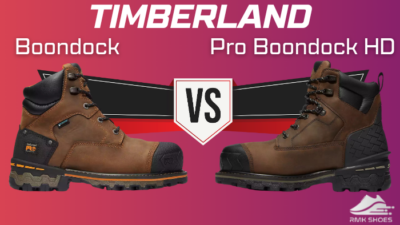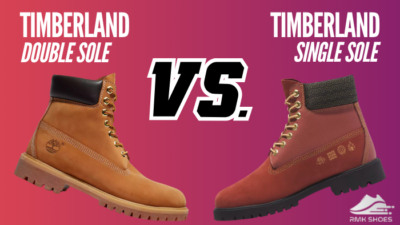I’ve run with many shoes besides popular brands like Nike and Adidas, but On is the one that provided the most comfortable and satisfactory performance throughout my session.
They make impressive running shoe series, Cloudswift and Cloudflyer, to deliver the top-notch user experience everyone is looking for.
Today, I’ll compare the latest versions from these series—Cloudswift 3 and Cloudflyer 4—to help you pick the most suitable pair.
So, let’s begin.
An Overview of On Cloudflyer 4 and Cloudswift 3
The mid-range running shoe market is very competitive. All the company tries to acquire this segment to maximize their profit margin.
The On is not different from the others. They have released the Cloudflyer and Cloudswift series to deliver the best performance and versatility in this range.
On Cloudflyer 4
The Cloudflyer 4 is a neutral daily trainer designed for runners seeking a plush, stable ride.
It is the latest version of the flyer series, released in 2022.
The shoe features advanced midsole and outsole technology from On to deliver the best running experience over a long distance.
Cloudflyer 4 has attracted the attention of stability and comfy runners with its fashion-forward design and superior capabilities.
On Cloudswift 3
The Cloudswift 3 is an amazingly versatile shoe capable of running short and long distances, exercising, etc.
It was released in 2023 and has shown significant improvement over the previous model to meet the expectations of runners.
The combination of cushioning and responsiveness has made it one of the most popular running shoes on the market.
Both Cloudflyer 4 and Cloudswift 3 are made for running. But, there are slight differences in their specifications, which makes their uses different.
Therefore, it’s necessary to learn about the details before purchasing one of these models.
Key Specifications of On Cloudswift 3 and On Cloudflyer 4
The On Cloudswift 3 and Cloudflyer 4 are exceptional running shoes for everyday usage.
They are made from one-year differences. So, there are differences between the technologies and materials.
It also affects the overall performance and comfort level of the shoes.
Let’s take a look at the specifications of Cloudswift 3 and Cloudflyer 4 to understand their characteristics better.
| Parameter | Cloudswift 3 | Cloudflyer 4 |
|---|---|---|
| Release Year | 2023 | 2022 |
| Upper Material | Zonal knit | Breathable engineered mesh |
| Midsole | CloudTec®, Dual-density Helion™, and Speedboard® | CloudTec®, Dual-density Helion™, and Speedboard® |
| Outsole | Rubber with CloudTec® pods | Rubber with CloudTec® pods |
| Stack Height | Heel: 33mm Forefoot: 28mm | Heel: 29mm Forefoot: 18mm |
| Heel-to-toe Drop | 5mm | 11mm |
| Weight | 11.3 oz/ 320 g | 10.58 oz/ 300 g |
| Cushioning | Medium | Plush |
| Lacing System | Standard | Star |
| Usage | Short run, mid-run, workouts | Daily training, long runs, recovery runs, walking |
Feature Comparison between On Cloudswift 3 and Cloudflyer 4
The Cloudswift 3 and Cloudflyer 4 are made for daily running purposes. They have many similarities in shoe technology, but the performance and comfort aren’t the same by any means.
For that, both models show significant differences in everyday usage.
Here are the feature comparison between On Cloudswift 3 and Cloudflyer 4:
1. Upper Material
The On Cloudswift 3 uses zonal knit for the upper construction. It’s slightly stretchy to give an inclusive fit.
The midfoot is covered with plastic material to provide extra support.
Cloudswift 3 is very breathable, thanks to its numerous perforations on the upper. It helps with ventilation and keeps the feet cool even in warm weather.
On the other hand, Cloudflyer 4 uses engineered mesh for the upper material.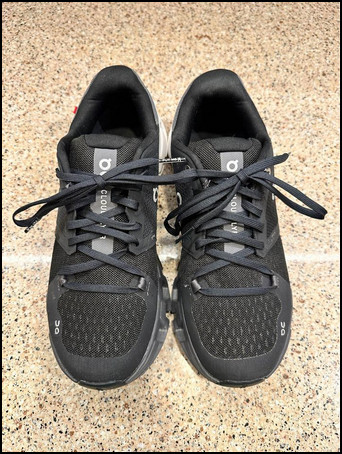
Similarly to the Cloudswift, the upper is made with two parts. One is made of mesh, and the other part at the midfoot is made from synthetic closed-off material.
The shoe is highly breathable in all seasons. It contains many perforations on the top for the best air ventilation.
The upper material feels much softer and very comfy to run with.
2. Design & Aesthetics
The On Cloudswift 3 has a very minimalistic design. It looks like an everyday sneakers by its appearance.
The upper is made from a single piece of knit material, with a plastic layer at the midfoot.
It works as eyelets for the shoe, and contains six eyelets on each side of the tongue.
The On Cloudswift 3 and Cloudrunner (Rumi February 1) use the same regular lacing system.
However, the Cloudswift 3 doesn’t have a separate physical tongue. Also, the shoe opening is smaller compared to most average shoes.
The heel counter at the back is curved inward to provide extra support.
The model comes in eight different colors, including black, white, brown, etc. All the variants look washed out to give a retro design.
In contrast, the On Cloudflyer 4 is bold and shiny. The design looks advanced and gives a polished appearance.
The toe box is made from engineered mesh, but the top has a layer of plastic, just like the midfoot area.
Cloudflyer 4 uses a start lacing system with six eyelets at each side of the tongue.
Speaking of the tongue, it has a regular tongue mechanism for better tightening. Unfortunately, the tongue is non-gusseted.
The heel counter curve is average, and the heel collar is slightly higher than Cloudswift.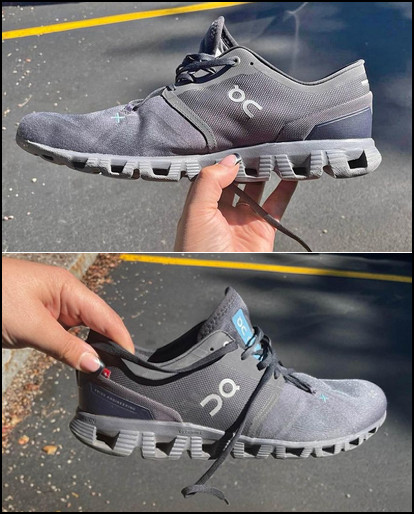
The color variation is very limited in this shoe. It offers only four color options in the market.
Both models have the same branding on the shoe. The On logo is present on the tongue, heel counter, and at the medial and lateral sides of the shoe.
3. Sole Technology
Both shoes use similar technology for the midsole and outsole. However, the implementation and thickness are different in both models.
Insole
Cloudswift 3 and Cloudflyer 4 use a foam insole or sockliner. Fortunately, both of them are removable.
So, you can replace it with a third-party orthotics insole for better arch support and comfort.
Midsole
The On Cloudswift 3 uses CloudTec® midsole with Dual-density Helion™ foam underneath.
The shoe also has a Speedboard® plate at the middle of the midsole. Its hard and rigid structure helps with the running and propels you forward in each stride.
It is moderately cushioned and provides excellent comfort while running. The Helion foam helps with the forward rolling and returns great energy to run more effortlessly.
The rolling method is the same in Cloudswift 3 and Cloudflow 4 (Naeem February 1) to help the stride runners.
Similarly, the Cloudflyer 4 uses the same CloudTec® midsole with Dual-density Helion™ and Speedboard® technology.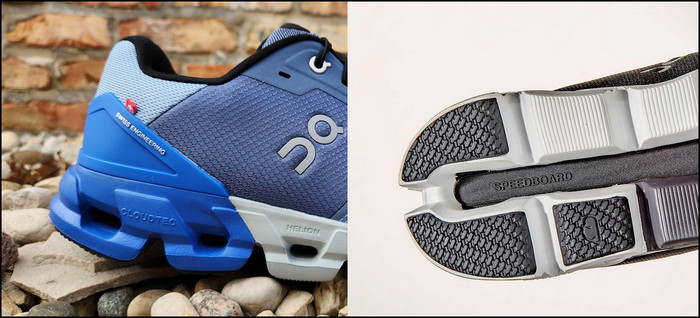
Both shoes should have performed similarly, but there’s a catch.
The midsole is divided into two parts, CloudTec and Helion.
The heel area is made with CloudTec technology. It’s hard, dense, and bigger than its previous generation.
Helion foam is very soft and bouncy. It absorbs the pressure and gives comfort in every step.
The Speedboard plate between the midsole bends and returns the necessary energy on each stride.
Outsole
The outsole technology is the same in both shoes. It’s made from rubber with CloudTec® pods at the bottom.
The pods absorb the impact and shrink inwards. After that, it returns to its original position and provides a great energy return.
But, the rubbery pad at the bottom is slightly different in Cloudswift 3 and Cloudflyer 4.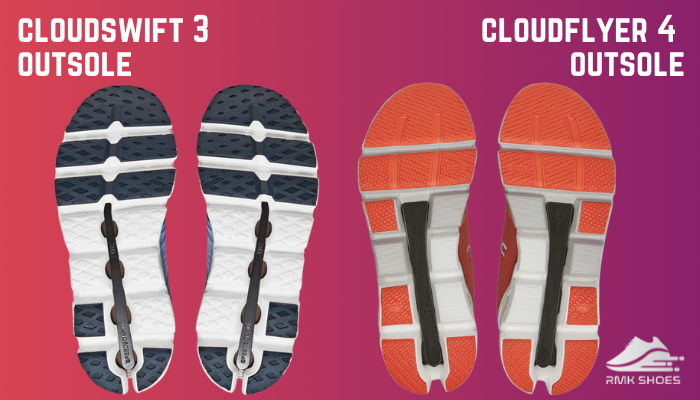
The On Cloudflyer 4 has an extra rubbery pad at the lateral side of the midfoot to provide more support and get a better grip.
4. Size & Weight
The On Cloud Cloudswift 3 and Cloudflyer 4 comes in true to size fit. Therefore, purchasing from the retail shop or online will provide perfect fittings.
| Parameter | Cloudswift 3 | Cloudflyer 4 |
|---|---|---|
| Stack Height | Heel: 33mm Forefoot: 28mm | Heel: 29mm Forefoot: 18mm |
| Heel-to-toe Drop | 5mm | 11mm |
| Weight | 11.3 oz/ 320 g | 10.58 oz/ 300 g |
The Cloudswift 3 has a higher stack height. But, the heel-to-toe drop is lower compared to Cloudflyer 4.
Both models are heavier than average running shoes. For the newer and denser technology, both shoes have gained almost 1 oz of weight than their predecessor.
5. Fit & Comfort
The Cloudswift 3 has a breathable upper. It has multiple holes in between the knit webbing.
It helps with air ventilation and keeps the feet dry and comfortable in all seasons.
The cushioning is medium in the Cloudswift 3. It’s not the best in terms of comfort, nor is it too hard to feel uncomfortable during running.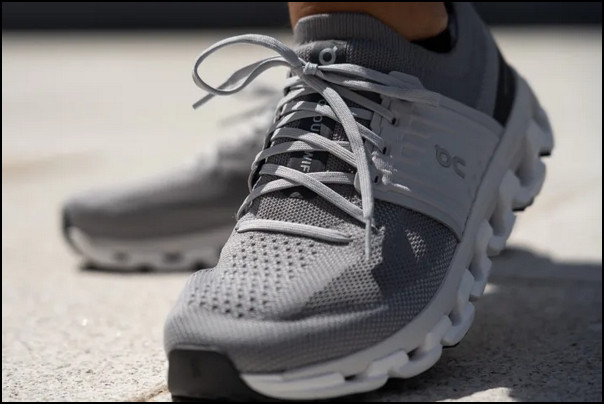
It’s pretty balanced and makes an all-rounder for every type of exercise.
The model doesn’t have a physical tongue. It’s more like a slide-in shoe, so I don’t feel the most comfortable tightening my laces.
But the curved heel counter holds my feet pretty well, which is a plus point.
The combination of cushioning around the heel collar and upper, with Helion foam under the midsole, provides sufficient comfort in running.
In contrast, the Cloudflyer 4 is one of the most well-padded models from On.
It has ample padding on the tongue, heel collar, and forefoot. Also, the heel counter has a thick foam layer for the best cushioning.
The shoe fits perfectly fine for most average feet. However, the toe box might feel tighter if you have a wide forefoot.
So, I suggest wearing the shoe before purchase, and size it up if the Cloudflyer feels too snug.
Also, there’s a wider version of this model for better fit and comfort.
The tongue is non-gusseted, but the thick foam makes it very comfortable after tightening the laces firmly.
The Helion midsole at the forefoot is very soft and cushiony. It’s the same as the Cloudswift 3, but the different mechanism has made it more comfortable to run.
6. Stability & Support
The stability and support system aren’t very exciting in On Cloudswift 3 and Cloudflyer 4.
Cloudswift is a neutral shoe. So, it doesn’t have sufficient arch support.
If you have flat feet, the shoe will be great for your daily running. But, for the high arch, it’s not the best-suited model.
The heel collar is pretty low in the On Cloudswift 3. Therefore, I don’t get good ankle support and cushioning while running.
But the curved heel counter is fantastic for providing good lockdown and support after wearing the shoe.
The rubber outsole pods are great for running on wet and dry surfaces. It grabs the ground and provides the necessary friction to run or walk confidently.
Compared to the Cloudswift 3, the On Cloudflyer 4 has slightly better stability and support.
The heel collar is higher, and ample cushioning around it gives good ankle support. Also, the heel counter is well-padded, which provides good heel coverage.
The Cloudflyer 4 is also a neutral shoe. For that reason, it doesn’t provide good arch support.
It offers additional padding at the bottom of the outsole compared to Cloudswift 3. It helps with traction and gives better support while running.
7. Durability & Performance
The On Cloudswift 3 offers excellent durability in every material of the shoe. The most impressive thing I’ve seen is the upper strength.
It can endure a lot of rubbing and be the same without any issues. The everyday scratch doesn’t affect the shoe.
The outsole’s durability is also impressive. The CloudTec rubber can last longer than the shoe lifespan.
With good care and maintenance, Cloudswift 3 can run 300+ miles pretty efficiently.
However, the upper toughness of On Cloudflyer 4 didn’t satisfy my expectations. The engineered mesh construction is good until there’s no scratch or ripping on the upper.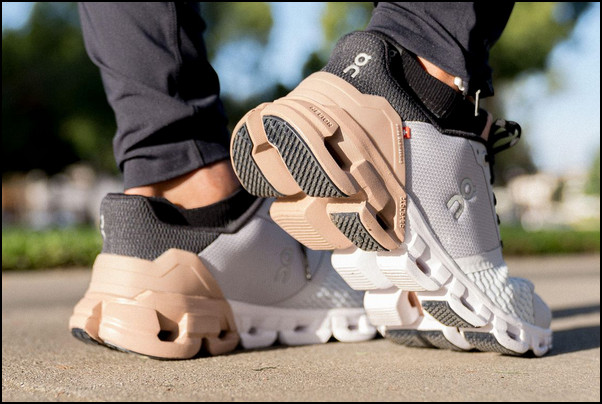
A small tear can cause the holes to enlarge very quickly.
Apart from the upper, the outsole’s durability is fantastic, as always. If you can keep the upper free from tearing, the shoe will last around 300 miles with good care.
8. Price Comparison
The pricing of the On Cloudswift 3 and Cloudflyer 4 is very similar.
- »Around 159.99
- »Around 169.99
There’s only a $10 difference between the models in retail shops and online stores.
Cloudswift and Cloudflyer are the pricey mid-range running shoes. The marginal differences make both shoes worthy and a perfect competitor in the market.
These models usually don’t come in discounts. However, if you manage to get one from a discount, it will be a value-for-money purchase.
Pros & Cons: Cloudswift 3 Vs. Cloudflyer 4
The On Cloudswift 3 and Cloudflyer 4 are great running shoes. But, if you compare it with the available products in the market, both models will show some advantages and disadvantages in regular usage.
On Cloudswift 3
- »Very durable upper.
- »Excellent breathability.
- »Regular lacing system.
- »Versatile shoes for short runs, long runs, and workouts.
- »Weight is more than average shoes.
On Cloudflyer 4
- »Very comfortable to ride on.
- »Improved midsole technology.
- »Excellent air ventilation.
- »Suitable for exercise.
- »Slightly more pricey than other models.
- »Upper durability is poor.
On Cloudswift 3 Vs. Cloudflyer 4: Which Should You Buy?
Both On Cloudswift 3 and Cloudflyer 4 are good running shoes. They do their job very well and give impressive performances.
However, they have slight differences in their material, which differs in the use cases.
If you prefer a responsive running short to mid-distance, quick run, and simple workouts, the Cloudswift 3 would be the better choice.
But if you are looking for plush and comfortable long-distance running shoes and workouts like weightlifting, the Cloudflyer 4 will be the perfect pick.
However, if you are confused between two shoes or looking for a versatile shoe, I suggest purchasing the On Cloudswift 3.
Frequently Asked Questions
Are On Cloudflyer 4 good for walking?
Yes, the On Cloudflyer 4 is suitable for walking short or medium distances. The upper and midsole are very soft to give a comfortable ride through the exercise.
Does Cloudswift have arch support?
No, Cloudswift doesn’t have arch support. It’s a neutral shoe, and the midfoot area is flat. So, if you need sufficient arch support, the shoe won’t provide that.
Is the Cloudflyer 4 waterproof?
No, the On Cloudflyer 4 isn’t waterproof. The engineered mesh upper is very easy to wet, and the numerous perforations will quickly soak your feet. However, this model has a waterproof version with an additional $10 cost.
What is the Cloudswift 3 used for?
The On Cloudswift 3 is suitable for versatile usage. The combination of plush and hardness makes it usable for short to long runs and simple workouts.

